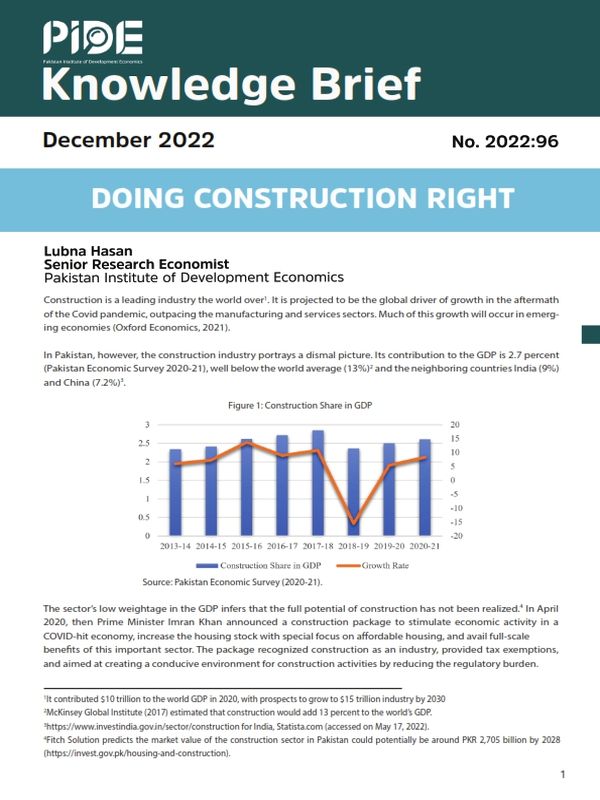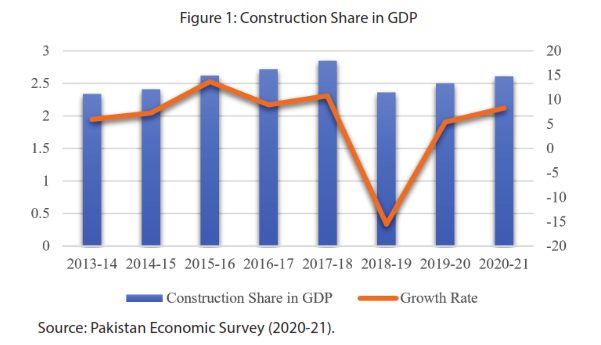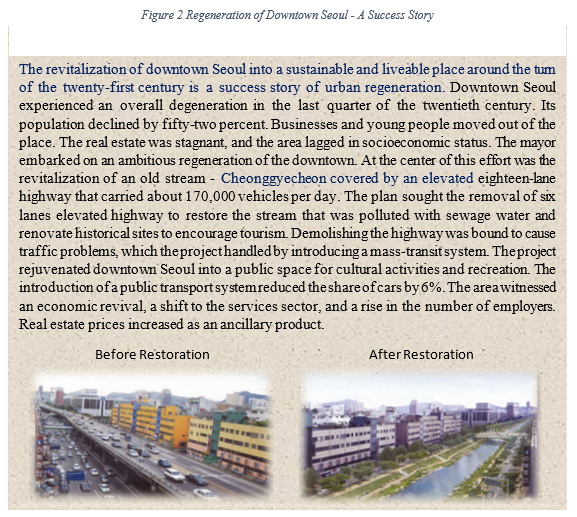Doing Construction Right
Construction is a leading industry the world over[1]. It is projected to be the global driver of growth in the aftermath of the Covid pandemic, outpacing the manufacturing and services sectors. Much of this growth will occur in emerging economies (Oxford Economics, 2021).
In Pakistan, however, the construction industry portrays a dismal picture. Its contribution to the GDP is 2.7 percent (Pakistan Economic Survey 2020-21), well below the world average (13%)[2] and the neighboring countries India (9%) and China (7.2%)[3].
The sector’s low weightage in the GDP infers that the full potential of construction has not been realized.[4] In April 2020, then Prime Minister Imran Khan announced a construction package to stimulate economic activity in a COVID-hit economy, increase the housing stock with special focus on affordable housing, and avail full-scale benefits of this important sector. The package recognized construction as an industry, provided tax exemptions, and aimed at creating a conducive environment for construction activities by reducing the regulatory burden.
__________
[1] It contributed $10 trillion to the world GDP in 2020, with prospects to grow to $15 trillion industry by 2030
[2] McKinsey Global Institute (2017) estimated that construction would add 13 percent to the world’s GDP.
[3] https://www.investindia.gov.in/ for India, Statista.com (accessed on May 17, 2022).
[4] Fitch Solution predicts the market value of the construction sector in Pakistan could potentially be around PKR 2,705 billion by 2028 (https://invest.gov.pk/).
__________
The Stimulus Package
- Construction was given a status of an industry.
- Various tax incentives were provided including a fixed tax regime for projects to be completed by 30 June 2023, reduction in withholding taxes, tax amnesty (till 30 June 2021), 90% reduction in taxes in case of low-cost housing approved by NPHDA
- Builders and developers were required to register with the SECP to avail of these benefits. Registration with the FBR on the IRIS portal and opening of a bank account was also mandatory.
- To free up money stuck in real estate, an exemption from the screening of source of income, as per Section 111 of the Income Tax Ordinance of 2001, was granted for capital invested in land or a building.
- A mortgage subsidy of PKR 30 billion for the first 100,000 houses being built for the
- Provincial taxes were Transaction duties amounting to around 8- 9 percent, and services cost about 8 percent were eased.
- Construction Industry Development Board (CIDB) was set up by the Ministry of Planning, Development, and Initiatives.
- Islamabad Real Estate (Regulation and Development) Act, 2020 was promulgated.
- The establishment of the Automated Approval Regime by the Capital Development Authority (CDA) and Lahore Development Authority (LDA) has reduced the approval time from years to
- The passing of a Foreclosure Law paved way for the banks to expand their mortgage Banks were required to keep 5 percent of their private sector advances for housing finance.
Did Construction Happen?
- According to FBR, a total of 2125 projects worth PKR 493 billion were registered under the PM’s Construction Package. 1,321 persons registered themselves through Bureau’s online system (The Nation, 2021).
- The initiative failed to gain momentum initially. As late as August 2020, only 40 projects had been registered with the FBR, with only six months remaining till the deadline (The News, 2020).
- The developers complained of bureaucratic hurdles and delays in getting certifications and approvals, citing a lack of coordination between different agencies and Development Authorities and slow processing of projects (ibid.). PIDE’s Sludge audit of construction permits has estimated that a simple process of getting a NOC for a high-rise building in CDA’s jurisdiction requires 12 steps and takes more than four years at the cost of PKR 2,156,410[5].
- Acquiring reliable contractors and workers was also difficult (Aurora, 2020). The COVID-19 pandemic had also dampened construction activities.
- The package picked up pace in the first half of 2021 as 2125 projects worth PKR 493 billion were registered with the FBR[6].
- PIDE has questioned the role of RERA and argued that it will only add to the regulatory burden and compliance cost for the real estate sector, rather than bring efficiency, transparency, and speedy dispute resolution of conflicts.
- The establishment of CIDB would make Pakistan Engineering Council (PEC) redundant by co-opting its functions. It is hard to justify that CIDB would not be just another government institution without improving the investment climate in the construction sector.
The question arises if it is the right way to hand out the ‘incentive package’ or do market development and deregulation steps need to be taken to get full-scale benefits from it.
__________
[5] This does not include time spent on preparing documents. When included, the total time required for a NOC is more than four years.
[6] Construction sector borrowing increased to PKR 88 billion, up 44 percent from last year’s same period (The News, 2021).
__________
Missing Elements of Reforms
- Pakistan’s construction sector is heavily regulated and controlled (PIDE PV, 12). The procedures and permissions required for construction are extensive and complex. For Karachi, before a builder can start work, about 20 no-objection certificates are needed from several departments (the Sindh Building Control Authority, Karachi Development Authority and Master Plan Department, CAA, SSGC, KE, KW&SB, PAF). According to the PIDE Sludge audit, the process can take many years to complete at significant monetary and time costs.
- The regulatory structure is not well defined either. A developer faces different regulators, spanning across different tiers of government and various Development Authorities. Each Development Authority has its own set of rules and procedures (PIDE’s Webinar on Prime Minister’s Construction Package, 2020).
- The difference between the market rate and the DC rate also impedes market development. Very low official property valuations provide individuals with a ‘legal’ way of under-documenting the transactions, those are benefited particularly who aim to minimise their tax liabilities or conceal their wealth as well as the source of income.
- Zoning regulations are rigid and prioritize residential over commercial and other uses. This, combined with excessive height restrictions imposed by building bylaws, has resulted in the geographic spread of the cities and housing societies with a focus on single-family houses. This inefficient use of land not only eats up the most precious asset of cities – its land but also imposes high transportation and pollution costs. Further, different land uses are compartmentalized, and the concept of mixed-use development is rare to find.
- The package does not underscore any area or type except housing. This lack of focus does benefit the status quo that alarmingly leads to grave urban sprawl and gated communities.
- PIDE’s research on housing societies in Islamabad has revealed that these societies take a long time, a decade on average, to develop. The construction cost would only increase with time, rendering owning a house a distant dream for a large proportion of the population.
The construction package in silos is akin to the sellers without the buyers. Urban development is the key to increasing economic activity, which is essential for creating buying powers for people to purchase housing units. We delineate an urban reform agenda that is needed in conjunction with the construction package for a more profound effect on the living conditions of the urban poor.
Construction that Works for Cities
The construction in urban planning has for far too long focused on single-family homes and urban sprawl. It is time to shift this paradigm to vertical cities, urban regeneration, and city life that supports agglomeration. Vertical development of cities makes housing affordable by distributing the cost of land to many owners. The densification and mixed-use of land in cities have other benefits like reduced dependence on cars.
Vertical Cities
PIDE has repeatedly argued in favour of high-rise construction allowing for dense city centres. It has maintained that:
- The flat is the unit of living in large cities the world over. In most Pakistani cities, barring Karachi, planners are still holding on to the notion of single-family homes and gated communities. This paradigm needs to change in favour of densification through high-rises.
- The land is the most precious asset that cities have. Flats make housing affordable by dividing the cost of land among many owners. They also make the most efficient use of land. Single-family homes and sprawl eat up this important resource.
- With increasing urbanization and population growth, the poor cannot be accommodated in single-family homes. Earlier efforts at social housing programs for the poor (Ashiana, Apna Ghar, etc.) failed because they had not factored in this issue. The same pattern of mistakes can now be noticed in the NPHP.
In comparison, the vertical growth of cities would:
- Avoid urban sprawl by densifying city centres through mixed-use, high-rise development.
- Avert high transportation and affiliated pollution costs,
- Reduce the cost of housing units,
- Lessen the welfare and municipality cost and expenditures,
- Have Sustainable and regenerated cities.
| A House is a flat in Big Cities.
“Globally, people in big cities live in flats/apartments in mixed-use neighborhoods with ease of access that encourages foot traffic eliminating the need for cars. Pakistani policy needs to learn from big cities in other countries and accept that large cities cannot be vibrant entities by spreading horizontally and must adopt the vertical growth model.” Haque and Khurshid (2020) |
Urban Regeneration
The city centers of our big cities (Sadars in various cities) are all dying, devoid of deserved economic activity because planners have overregulated them. Building regulations prevent city centers from rejuvenating. Most poor want to live near their places of work, be it the center of the city, to save on their cost of travel. The land is most expensive in the city centers. It is where most job opportunities exist and where poor people want to live. Building houses far away from city centers will add to the misery of the poor by increasing travel time and cost.
Any national construction plan must consider urban regeneration to elevate life in preexisting urban areas. Let city centers densify through the development of flats living in high (10 or more floors) or midrise (less than 10 floors) buildings and allow for mixed-use there. Density gradually reduces with distance from city centers.
Pakistan has archaic construction regulations which have seldom been reviewed. Building and zoning regulations are excessively restrictive, favoring gated communities and sprawl. The construction industry, which is a leading sector in other countries, has been killed by excessive regulation. PIDE has long argued for zoning and building regulations to be flexible to allow for dense, mixed-use developments that enhance mobility, creativity, and productivity (Haque 2015, 2020, Policy Viewpoint 2, 12, 13, 16). Further, the government needs to ensure that cities have coherent jurisdiction. Lahore, e.g., is divided into almost five overlapping jurisdictions of LDA, Municipal Corporation, DHA, Cantt, etc., and Karachi has 19 agencies, including DHAs, Municipalities, and Federal Housing Schemes. There are no defined city limits, and mere plot-making stretches cities in strange directions.
City planners must embrace these ideas to:
- Deregulate the cities. Contrary to popular belief, the planner has no tools to develop clarity on where and what to build. Worldwide, city planners are moving away from rigid masterplans to neighbourhood planning. More and more cities are now developing flexible guidelines that allow markets to take decisions on usage, height, and cityscape.
- Allow zoning and building rules to be flexible. Let city centres densify through the development of flats living in high (10 or more floors) or midrise (less than 10 floors) buildings and relax zoning laws to allow for mixed-use (commercial and residential) development. Dense city centres with commercial activities will encourage more sustainable modes of mobility (walking and biking)
Deregulation
| “A wholesale deregulation of the real estate sector to facilitate development, transactions, and investment is required. What is holding back real estate development is too many convoluted government regulations based on excessive requirements of permissions and documentation, and outmoded thinking. There is a clear need to check our mercantilist approach and recognise that all economic activity, including real estate investment and development, is productive. In fact, economic activity begins with purpose-built real estate in cities.”
Haque and Khurshid (2020) |
Simple Rules and their Enactment
The government needs to ensure the uniformity and simplicity of rules to incentivize developers across the board. Also, the investors do need liquidity of resources for such large projects. Therefore, the state needs to introduce simple laws and do away with the complicated rules and regulations; for they only serve to impede construction and development.
Conclusion
The government can use this moment to incentivize and streamline its preferences by:
- Enacting (simplifying) laws and reducing the layered over-regulation of markets,
- Relaxing Zoning
- Encouraging and incentivising high-rise and mixed-use buildings,
- Push further for the condominium law, multiple ownership laws, and reducing the costs of housing units,
- Promoting urban regeneration in Pakistan,
- Working with financial institutions to encourage financing for high-rises,
The construction sector needs a holistic approach where urban development is at the center of the reform agenda. Creating job opportunities for the urban poor is the only way forward for raising their living standards and sheltering them. Increased economic activity would cater to the demand side by improving buying power of the people. Whereas a high-density, mixed-use urban form will aid the supply-side problems by reducing the inflated costs of house ownership through condominiums and apartments, along with the associated benefits of reduced transportation and pollution costs. A one-off provision of housing is not sustainable. A comprehensive reform effort aimed at high-rise construction, urban regeneration, and deregulation will pave the way for doing the construction right (PIDE Viewpoint 12).
References
Aurora (2020). Will the Construction Industry Revive Pakistan’s Economy? Retrieved from: https://aurora.dawn.com/news/1143877
GOP (2019-20) Pakistan Economic Survey. Economic Advisor’s Wing. Finance Division. Government of Pakistan. Islamabad
Haque, N. (2015). Flawed Urban Development Policies in Pakistan. Working Paper 119. Pakistan Institute of Development Economics. Islamabad.
Haque, N. (2020). Contexualizing Pakistan’s Cities. Pakistan Institute of Development Economics. Islamabad.
Haque, N. and N. Khurshid (2020). Construction Without Real Estate Development. PIDE Working Paper Series No 2020: 9. Pakistan Institute of Development Economics. Islamabad.
McKinsey Global Institute (2017). Reinventing Construction through a Productivity Revolution. https://www.mckinsey.com/business-functions/operations/our-insights/reinventing-construction-through-a-productivity-revolution
Oxford Economics (2021). The Future of Construction. A Global Forecast for Construction for 2030. Oxford Economics Ltd. London. Retrieved from: https://resources.oxfordeconomics.com/hubfs/Future%20of%20Construction_Full%20Report_FINAL.pdf
PACRA (2021). Construction Sector. The Pakistan Credit Rating Agency Limited. Retrieved from: https://www.pacra.com/sector_research/Construction%20-
PIDE (2020). Lahore’s Urban Dilemma- Doing Cities Better. PIDE Policy Viewpoint 12. Pakistan Institute of Development Economics. Islamabad
PIDE (2020). PIDE’s Webinar on Prime Minister’s Construction Package. Retrieved from: https://pide.org.pk/index.php/89-pide/research/seminars/699-webinar-on-prime-minister-s-construction-package
PIDE (2020). The Islamabad Master Plan. PIDE Policy Viewpoint 16. Pakistan Institute of Development Economics. Islamabad
PIDE (2007). Renew Cities to be Engines of Growth. PIDE Policy Viewpoint 2. Pakistan Institute of Development Economics. Islamabad
The Nation (September 11, 2021). Total investment in projects of PM’s Construction Package reaches Rs493b. Retrieved from: https://nation.com.pk/11-Sep-2021/total- investment-in-projects-of-pm-s-construction-package-reaches-rs493b
The News (August 15, 2020). Developers, builders unable to fully avail incentives of PM’s construction package. Retrieved from: shorturl.at/gzMSX






